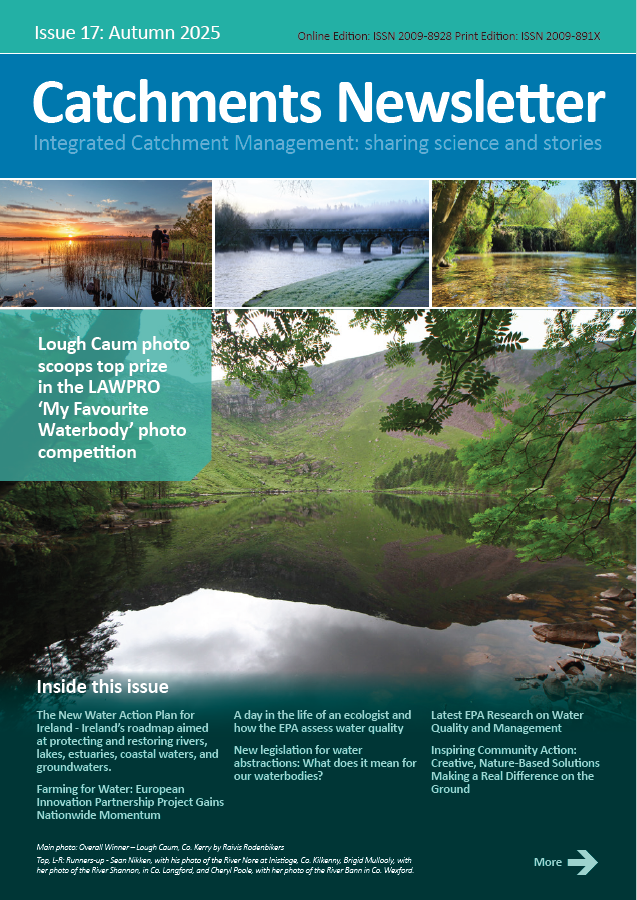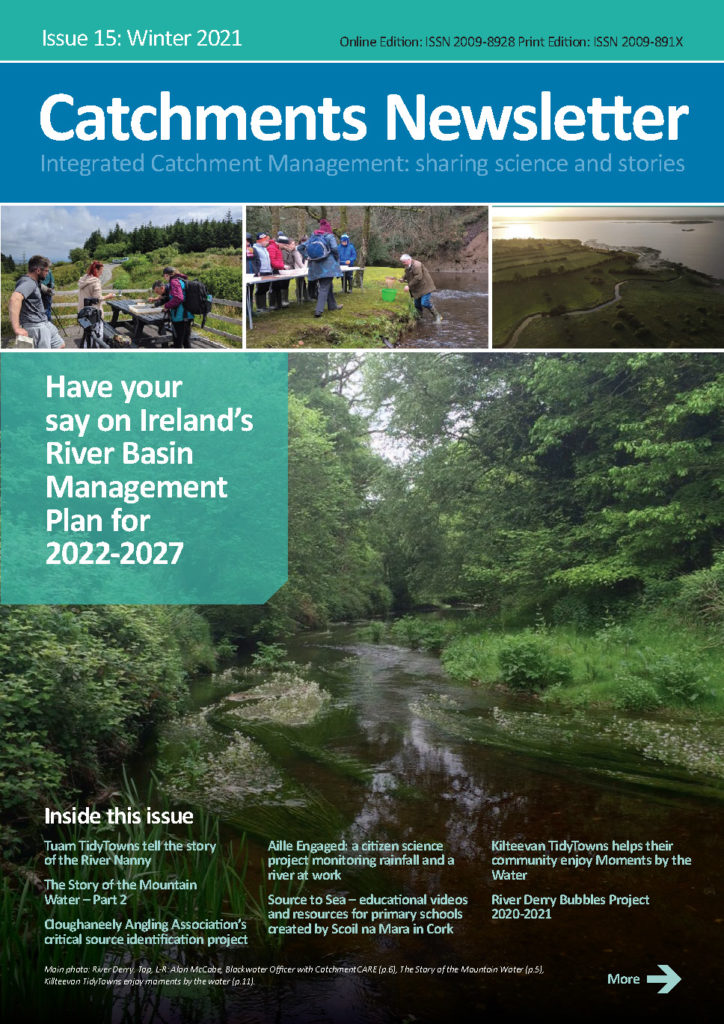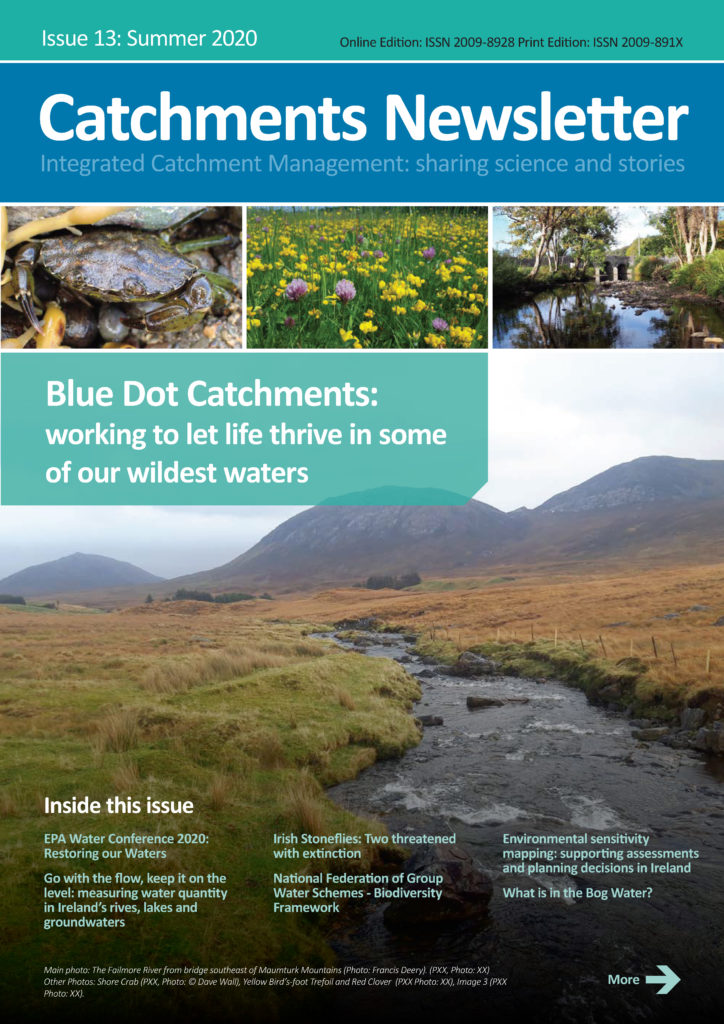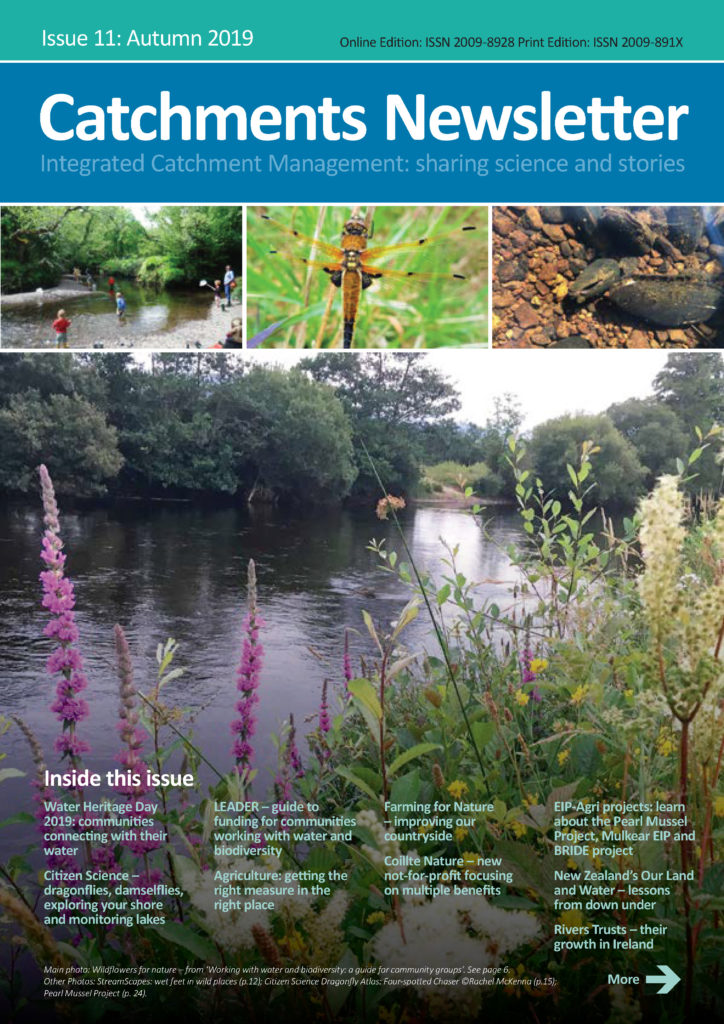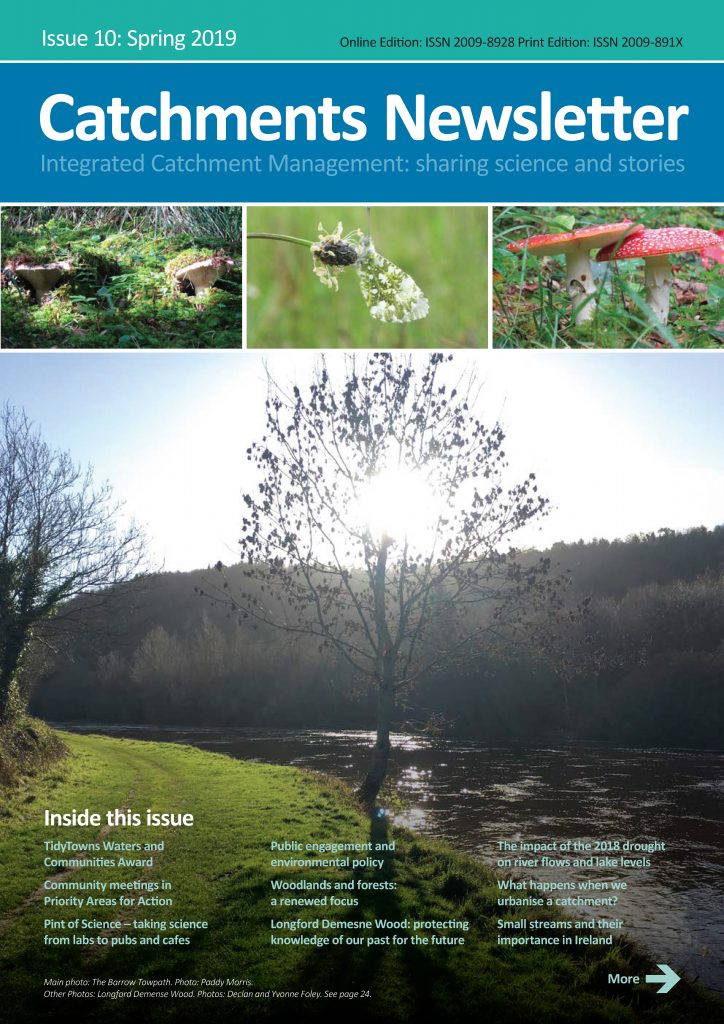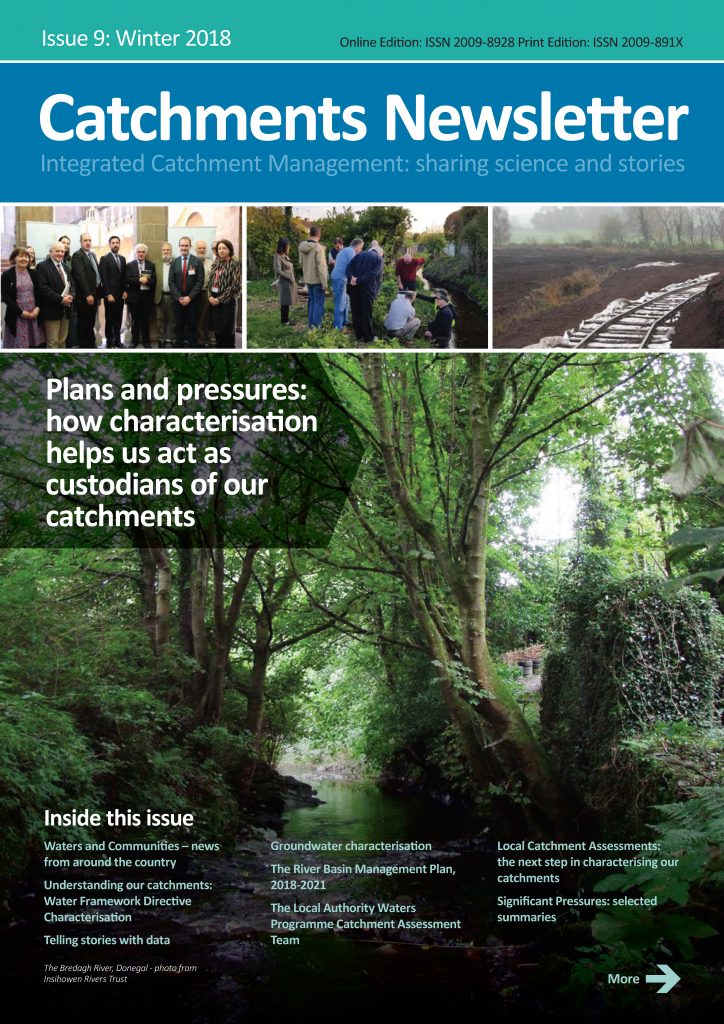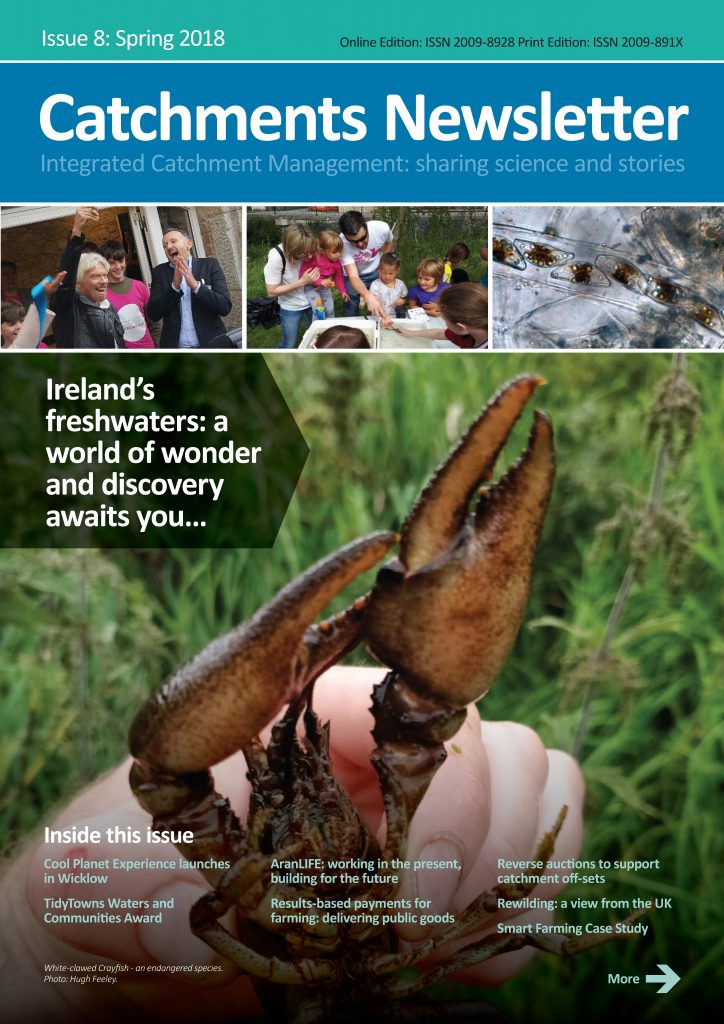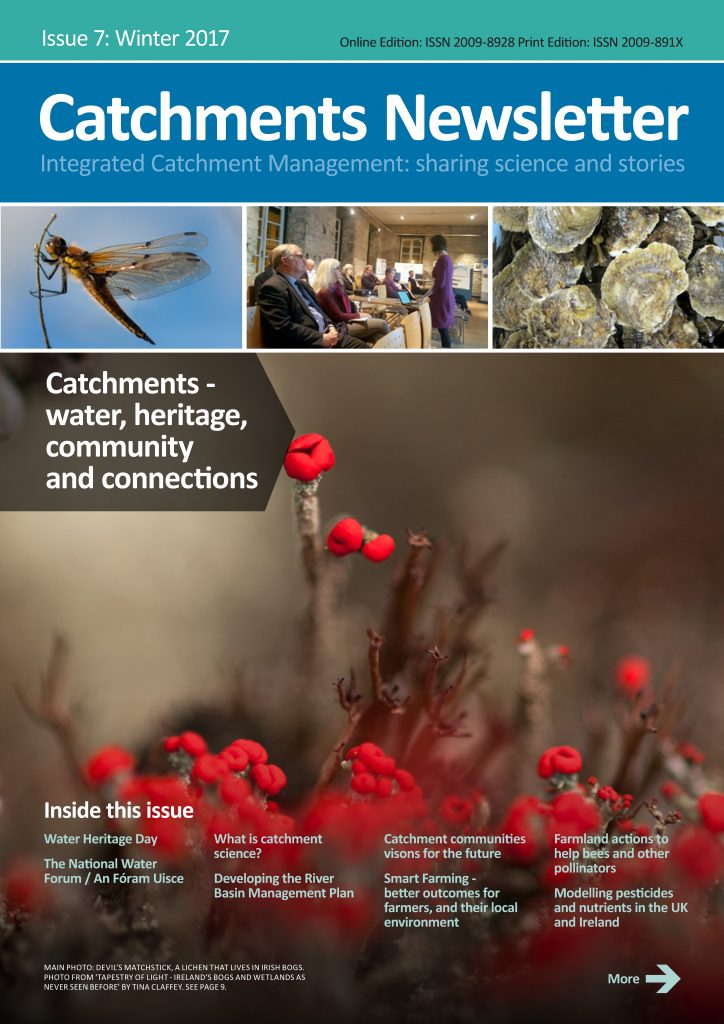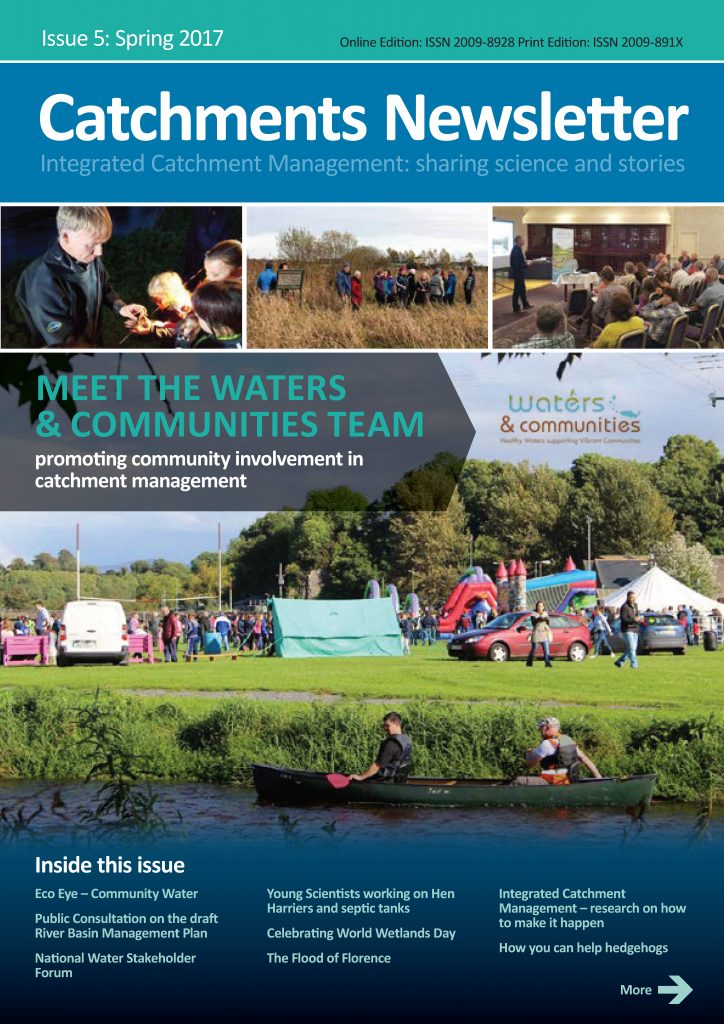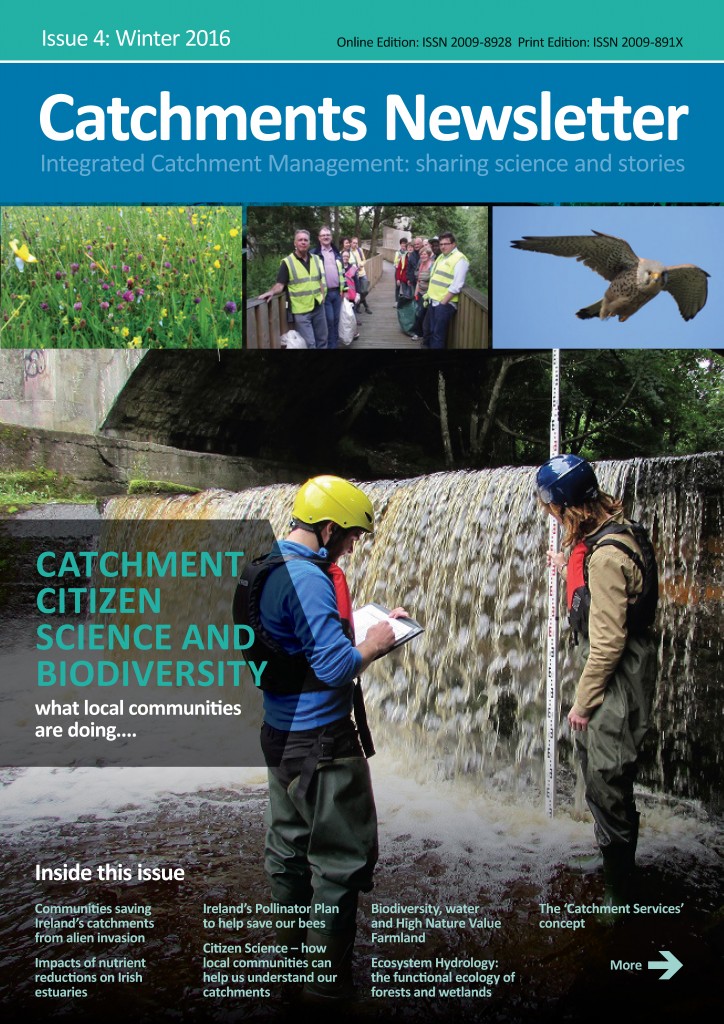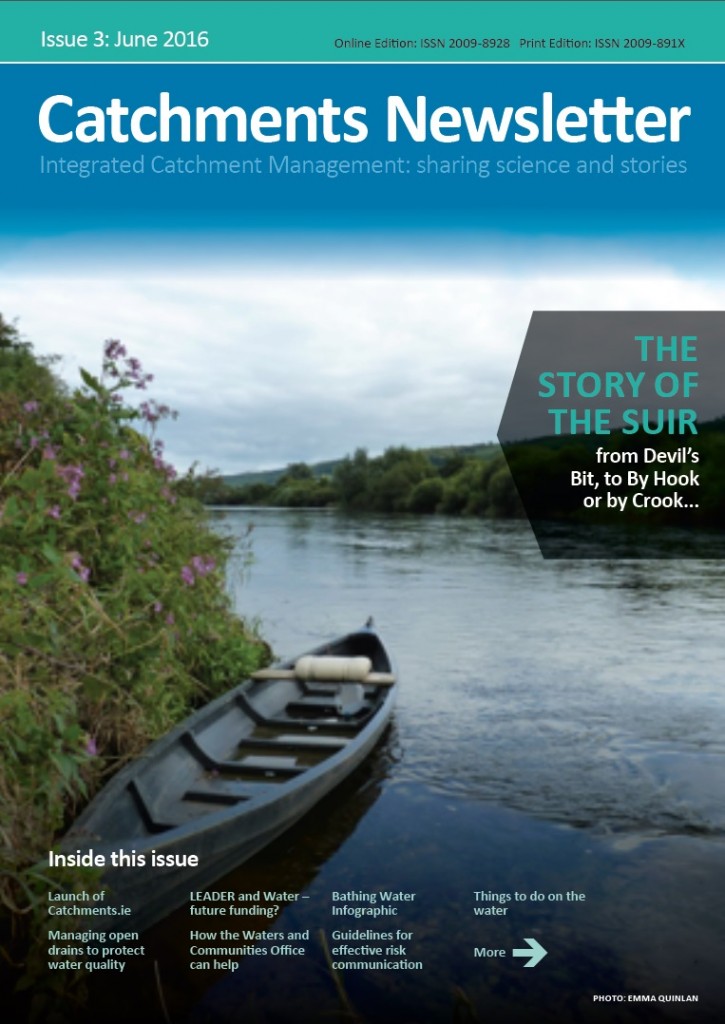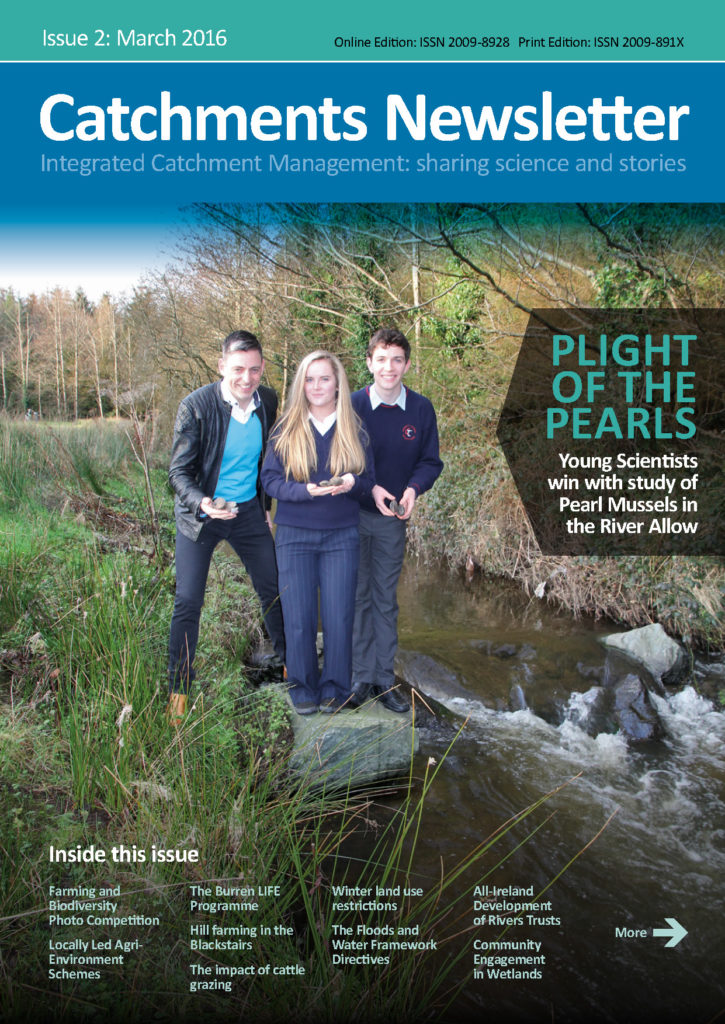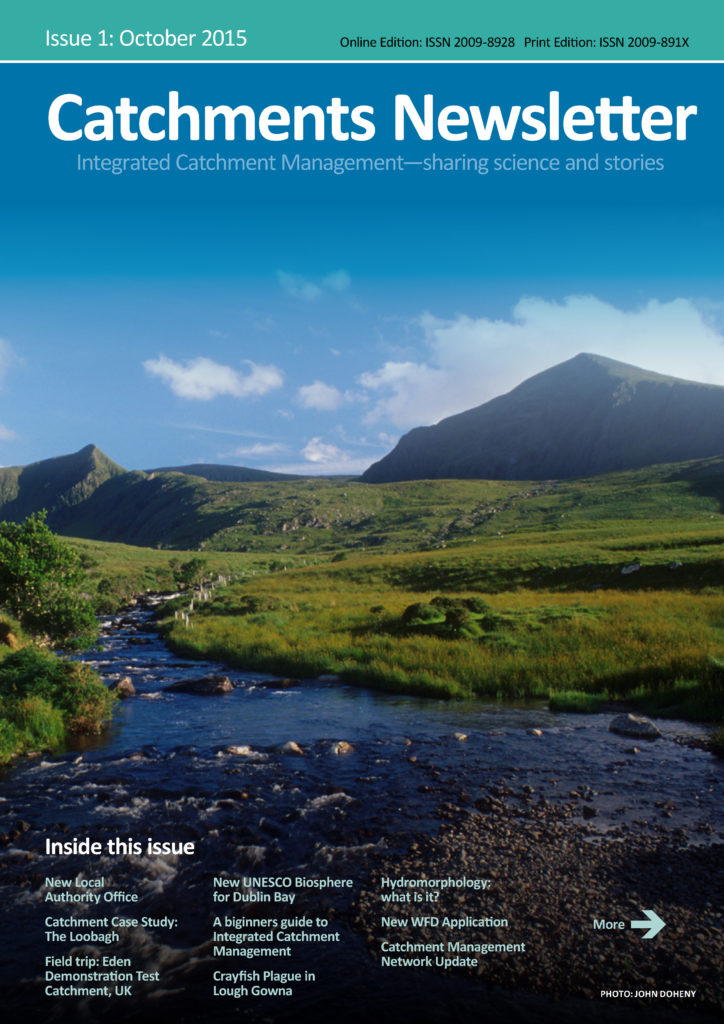
Catchments Newsletter
Our Catchments Newsletter brings together science and stories from community groups, local authorities, public bodies, researchers, the EPA and the Local Authority Waters Programme, and others about the different ways we all work together to care for Ireland’s rivers, lakes, streams and coastal waters so they can be protected, and restored where necessary.
Your water, your catchment – 2017 video highlighting how we all are connected to and depend on water and catchments
Have you a story to tell?
We want to tell stories than help people understand the connections between them, their local community’s environment, and enhancing human health. We also want to promote public participation.
If you have a story for a future issue, please get in touch using our Contact page or get in touch with your local Community Water Officer.
We want these stories to inspire more people to take part in looking after their local community’s environment, and particularly our waterbodies.
“Lively and engaging”
– Michael Viney, The Irish Times
Issue 17: Autumn 2025 Catchments Newsletter
Inside this issue
Waters and Communities News
Highlights include the launch of Ireland’s Water Action Plan, major funding for community water projects, and inspiring local initiatives in Westport, Ballinahown, Enniscorthy, and the Nore catchment.
Bathing Waters
EPA updates on bathing water quality and infrastructure improvements, citizen science through Explore Your Shore!, and coastal action led by the Tomhaggard Clean Coasts Group.
EPA Water Quality
Insights into how the EPA monitors and assesses water quality, new legislation on water abstractions, and key takeaways from the EPA Water Conference 2025.
Articles
- Better Farming for Water – 8 Actions for Change campaign launched by Teagasc.
- Linking Monitoring and Research with the Restoration of Nephin Forest – combining long-term data and ecological restoration.
- River Flow and Ecology Case Study: The Lotic-invertebrate Index for Flow Evaluation (LIFE) in Irish Rivers.
- Insights into the Peatlands Climate Action Scheme and its impact on water quality.
- Catchment-wide interventions by The Rivers Trust to tackle blue-green algae in Lough Neagh.
- Reflections from the Waters of LIFE project – working one farmer at a time to reduce agricultural pressures.
Issue 16: Summer 2024 Catchments Newsletter
In this issue:
Waters and Communities News:
Winners of LAWPRO’s ‘My Favourite Waterbody’ photography competition; Lough Masks’ Arctic Char mosaic; East Corrib Alliance restore their river; Restoring Drummin Bog in Carlow; Cabragh Wetlands Trust restoring semi-natural floodplains; Slaney workshop on a catchment community forum; Middleton GAA club use the Green Club Water Action Fund; LAWPRO’s Community Water Development Fund and Catchment Support Fund.
Articles:
The Water Action Plan 2024; Water Quality in 2023 – an indicators report; watch the 2024 EPA Water Conference Online; EPA update on the Significant Pressures impacting water quality; updated Catchment Assessments and master spreadsheet available; ESRI research on farmers knowledge, attitudes and intentions towards water quality; New map EPA available on Targeting Agricultural Measures; the Farming for Water EIP, including a willow bed case study; Waters of Life – trialling water quality solutions; national implementation strategy for nature-based solutions; Water Forum educational modules for schools; FarmPEAT – working with farmers on midlands raised bogs; An Taisce launch The Irish Pond Manual; and finally, a discussion piece on drained peaty soils.
Winter 2021 Catchments Newsletter
In this issue:
Waters and Communities News:
Tuam TidyTowns tell the story of the River Nanny; The Story of the Mountain Water – Part 2; Cloughaneely Angling Association’s critical source identification project; Aille Engaged: a citizen science project monitoring rainfall and a river at work; Source to Sea – educational videos and resources for primary schools created by Scoil na Mara in Cork; Kilteevan TidyTowns helps their community enjoy Moments by the Water; River Derry Bubbles Project 2020-2021.
Articles:
Public consultation opened on Ireland’s draft River Basin Management Plan for 2022-2027; Water Quality in 2020: An Indicators Report; EPA publishes an assessment of which catchments need reductions in nitrogen concentrations; EPA submission on the fourth review of Ireland’s Nitrate action Programme: EPA publishes 46 updated draft Catchment Assessments on catchments.ie to support public consultation on the draft River Basin Management Plan; Public consultation and local engagement on the draft River Basin Management Plan for Ireland 2022 – 2027; Ireland’s Quality Rating (Q-Value) River Monitoring System 1971-2021 – how 50 years of looking at what lives in our rivers can tell us about the health of our freshwater ecosystems; Local Authority Waters Programme launches their new website www.lawaters.ie; Ireland’s River Basin Management Plan: regional governance structures – what do they do?; Smart Farming Seminar: Sources and Solutions – the link between our soils & water quality; Nature-based Catchment Management – working with nature to benefit biodiversity, water and the climate; The Water Forum – working together for water quality; The Water Forum – fact sheet on the River Basin Management Plan.
Spring 2021 Catchments Newsletter
In this issue:
Waters and Communities News: Stories from the Waterside; local community protect Lough Gill, County Kerry from invasive species; The Caha Project; NoreVision – become a river guardian; Inishowen Rivers Trust launch their Riverview newsletter; Camac Connections: the River Camac in Clondalkin published by Friends of the River Camac; Communities Caring for Water conference; Community Water Development Fund 2021.
Articles: EPA publishes Water Quality in 2019 – an indicators report; World Wetlands Day 2021; 2,200 acres of uplands gifted to An Tasice at Sleabh Beagh; Nature-based Sustainable Urban Drainage Systems; EPA publishes Ireland’s Environment – an integrated assessment 2020; EPA Research 36$: Learning from Group Water Schemes; DCU Water Institute Backdrop project – citizen science along the Liffey; Geological Survey of Ireland: regional assessment of groundwater resources
Summer 2020 Catchments Newsletter
In this issue:
Waters and Communities News: Citizen science on our rocky shorelines; Nature on our Doorsteps; Stoneybatter’s water mural and pollinator plan; online community meetings; The LAWPRO Community Water Fund.
Articles: EPA Water Conference 2020; new Water Map and Chemistry downloads on catchments.ie; An Forum Usice on public involvement in decision making; measuring water flows and levels; stonefly threatened with extinction; Blue Dot Catchments; NFGWS Biodiversity Framework; Environmental Sensitivity Mapping; Natural Capital Accounting; The Living Bog’s water; The Flood of Venice.
Winter 2019 Catchments Newsletter
In this issue:
- Waters and Communities News:
- Lough Carra marl lake and its marl crusts; Leitrim meeting on bogland and climate; Dublin Community Clean-up; Rossmore Park balasm bashing; Galway Waterways Foundation.
- Articles:
- Water Quality in Ireland 2013-2018; European Environment Agency’s ‘The European environment – state and outlook 2020’; An Fóram Uisce – The Water Forum; Natural Water Retention Measures; Crayfish plague; Catch Crops; Smart Farming Water Guidance; WaterMARKE; NFGWS pollinator friendly pumphouses; Source to Tap on MCPA in their catchments; IPCC volunteer-led peatland restoration; and research on blanket bogs and invasive species.
Autumn 2019 Catchments Newsletter
In this issue:
- Waters and Communities News
- Water Heritage Day; LEADER funding for water and biodiversity; the growth of Rivers Trusts in Ireland; StreamScapes and thier thirty years of working with communities.
- Articles
- Citizen science – dragonfly and damselfly survey, Explore Your Shore, and anglers monitoring lakes; Coillte Nature; Farming for Nature; The Blue Dots Catchment Programme; The Freshwater Pearl Mussel and Mulkear European Innovation Projects; Our Land and Water – New Zealand’s National Science Challenge; Smart Farming’s Spring seminar; Agriculture – getting the right measure in the right place; research on nutrient use benchmarks and legacy phosphorus; and a map of all the EIP-Agri projects in Ireland thanks to the National Rural Network.
Spring 2019 Catchments Newsletter
- Waters and Communities news from around the country:
- TidyTowns Waters and Communities Award and 2018 winners, Abbey County Galway
- Community Information Meetings in Priority Areas for Action
- Dublin: The River Camac tells a story
- Galway: Loughrea Lake birdwatching and beach clean up
- Leitrim: anglers protecting small streams
- Longford: primary school kids learning about their water and wildlife
- Roscommon: telling the story of the Portrunny catchment
- Wexford: schoolchildren working together to understand their local streams and get their community involved
- Pint of Science; from labs, to pubs and cafes
- Public consultation: timetable and work programme for Ireland’s River Basin Management Plan 2022-2027
- Public engagement and environmental policy
- Ireland’s woodlands and forests: a renewed focus under the second cycle of the River Basin Management Plan
- Measuring the impact of the 2018 summer drought on river lakes and flows
- Donation of EPA hydrometric equipment to Engineers Without Borders
- Dingle Hub: real-time remote sensing to allow continuous water quality monitoring
- Research projects:
- Acclimatize – addressing pollution in urban and rural bathing waters
- EU SWIM Project prepares for the 2019 bathing water Season
- Small streams and their importance in Ireland
- The WISDOM Project: learning from Group Water Schemes and connecting water, infrastructure, and people
- Book reviews:
- Wilding: the return of nature to a British farm
- Karst of Ireland: Landscape, Hydrology, Methods
Winter 2018 Catchments Newsletter
- Waters and Communities: news from around the country
- Cavan: protecting drinking water from pesticides
- Donegal: Source to Tap and Slow the Flow
- Dublin: World Water Day and Dublin Water Action Day
- Galway: Cuan Beo and Galway Bay, celebrating the River Nanny, The Irish Workhouse Centre, and Glenamaddy Tidy Town’s Turlough
- Mayo: Castlebar Community Clean, and Ballina Salmon Festival
- Westmeath: Athlone’s community spirit, and St. Joseph’s Foroige, Streamstown
- Understanding our catchments: Water Framework Directive characterisation
- The River Basin Management Plan, 2018-2021
- The Local Authority Waters Programme Catchment Assessment Team
- Significant Pressures: selected summaries
- Agriculture
- Hydromorphology
- Forestry
- Peat
- Urban Waste Water
- Invasive Species
- Telling stories with data
- Local Catchment Assessments – the next step in characterising our catchments
- Map: Priority Areas for Action, 2018-2021
Spring 2018 Catchments Newsletter
- Ireland’s freshwaters: a world of wonder and discovery awaits you
- News and events:
- Cool Planet Experience launched in Wicklow
- Source to Tap in Erne and Derg catchments
- Tidy Towns: Waters and Communities Special Award, and celebrating community success in Ashbourne
- River Explorers by Leave No Trace
- Teagasc Agricultural Catchments join Twitter
- Hydrogeologist field trip report
- Poster: How you can Clean, Check Dry your wet gear to help save the White-clawed Crayfish
- AranLIFE: working in the present, building for the future
- Results-based payments for farming: delivering high quality biodiversity and other public goods
- Time to rewild? – a view from across the Irish sea
- Smart Farming Case Study
- Using reverse auctions to support delivery of catchment off-sets
- It’s all about the algae
Winter 2017 Catchments Newsletter
- Water Heritage Day – events held all around Ireland
- Launch of the ‘Sustainability Support and Advisory Programme’ to improve water quality
- Books:
- Tapestry of Light – Ireland’s bogs and wetlands as never seen before
- Dublin Bay – Nature and History
- The National Water Forum – working for the common good
- Developing the next River Basin Management Plan: a collaborative approach involving communities
- What is catchment Science?
- Local communities developing a vision for their water catchments – The Nore, Thomastown, Dundalk Bay, The Dodder, and Galway Bay
- Smart Farming
- Farmland guidelines to help pollinators
- Tackling invasive species in Cork
- Science: Shannon bird survey, modelling catchment management solutions for pesticides in the UK, and Irish nutrient modelling that indicates most losses to surface waters are from diffuse sources
- Resources: New EPA Research reports on climate change, catchment services, sediment flux, Natural Organic Matter (NOM) and Ptaquiloside, and the benefits of good water quality for water-based leisure activities
Autumn 2017 Catchments Newsletter
- News from Rivers Trusts and Workshops around Ireland
- Launch of Beaches.ie
- Engaging local communities on the draft River Basin Management Plan
- New EPA report: Water Quality in Ireland 2010-2015
- Outcomes of Catchment Characterisation
- How climate change can bring us together
- Tackling Invasive Species
- Understanding and managing freshwater and their ecosystems
- Forestry, bogs and wetlands – how they can contribute to a healthy environment
Spring 2017 Catchments Newsletter
- The Waters and Communities Office – introducing their team and what they do
- Details on the public consultation on the draft River Basin Management Plan
- The new National Forum on Water
- Launch of new app to track some invasive species of plants by Limerick City and County Council, and a story about how Offaly have managed their invasive species
- Stories from Italy and Australia about managing floods and drinking water
- Some winning entries from this year’s Young Scientists exhibition
- The Uisce Aille education project on Integrated Catchment Management in The Burren
- Stories from the Mulkear, Funshion and Moy about how local communities are working together to help manage their catchments
- How one volunteer is helping look after wild Irish hedgehogs
- Love Your River Telford – an example of urban catchment management in the UK
- And lots more…
Winter 2016 Catchments Newsletter
- Citizen Science – mapping river obstacles, identifying flies, how tea bags can help you do some science, community catchment science from Antrim, and the Lough Derg Native Fish Biodiversity Project.
- Communities managing invasive species in Achill and Kilkenny,
- High Nature Value Farmland and ‘Sustainable Intensification’
- The impact of nutrient reduction measures on Irish estuaries
- Biodiversity – the variety of life, saving native apple trees and bees, the All-Ireland Pollinator Plan, and detection of predators in the Avon Catchment (UK).
- Ecosystem Hydrology
- Climate Change Impacts
- National Federation of Group Water Schemes – Septic Tanks Systems Desludging pilot
- The ‘Catchment Services’ concept
- Resources: Citizen Science for birds, biodiversity and coasts; reporting pollution with an app, urban gardens, Natura 2000
June 2016 Catchments Newsletter
- There are several articles highlighting the work that has been done on the Suir catchment, looking at how healthy the catchment is and the chemistry, biology, flow, and more.
- Technical Note: Electrical Conductivity – a useful tool for investigating catchment hydrology
- Teagasc on Protecting Open Drains
- An update on the Waters and Communities Office
- LEADER and funding opportunities
- Freshwater Aquaculture – the MOREFISH project
- Resources Section: GSI Groundwater Newsletter, Rural Water News, HAB Bulletin, White tailed eagles and anglers, Waterways Ireland Holiday guides, NESC on Burren LIFE, Irish Forum on Natural Capital, How local communities can help pollinators, and more…
March 2016 Catchments Newsletter
- Locally-led agricultural schemes – 10 step guide to startinga scheme, Burren LIFE, The Blackstairs Hill Farming Group.
- Duhallow LIFE – community led conservation
- Cattle – Kerry research on conservation grazing, and a study on their impact on freshwater ecosystems
- Winter land use restrictions
- Drinking Water Safety Plans
- Ireland’s Catchment Flood Risk and Assessment Programme
- Sustainable community engagement in Wetlands
- Water Framework Directive Typologies for lakes
- Agricultural Catchments Programme – Phase 3
- Farming and Biodiversity Photo Competition with Streamscapes and IASTA
- The Water Policy Advisory Committee
- The Water Framework Directive Application – managing and sharing water data
- Resources Section: Natural Flood Measures, The Wheel on Commissioning for Communities and EU funding for non-profits, making Room for The River, Dredging: a reality check, Natural Capital challenges in the Dairy Sector, and more…
November 2015 Catchments Newsletter
- The new Local Authority Waters and Communities Office,
- Catchment Case Study: The Loobagh in Limerick
- A beginners guide to integrated catchment management
- An explanation of hydromorphology
- Dublin Bay Biosphere
- Crayfish plague in Lough Gowna
- Field Trip: Eden Test Catchment, UK
Who is involved?
Quite simply, everyone in Ireland has a role to play. This can be from something as simple as making sure you don’t pollute your local stream, or a local community working together to establish a Rivers Trust to enhance the rivers and lakes in their area, to a Government Department or Agency helping a Minister implement a new policy to help protect and enhance all our water bodies.
This website has been developed and is maintained by the Environmental Protection Agency, and is a collaboration between the Department of Housing, Planning and Local Government, the Environmental Protection Agency, and the Local Authority Waters Programme.

Local Authority Waters Programme
The Local Authority Waters Programme coordinates the efforts of local authorities and other public bodies in the implementation of the River Basin Management Plan, and supports local community and stakeholder involvement in managing our natural waters, for everyone’s benefit.

Environmental Protection Agency
The EPA is responsible for coordinating the monitoring, assessment and reporting on the status of our 4,842 water bodies, looking at trends and changes, determining which waterbodies are at risk and what could be causing this, and drafting environmental objectives for each.

Department of Housing, Local Government and Heritage
The Department is responsible for making sure that the right policies, regulations and resources are in place to implement the Water Framework Directive, and developing a River Basin Management Plan and Programme of Measures to protect and restore our waters.

